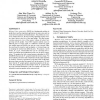23 search results - page 2 / 5 » Graphs Without Large Complete Minors Are Quasi-Random |
COMBINATORICA
2010
13 years 4 months ago
2010
In this paper, we propose a simple and natural randomized algorithm to embed a tree T in a given graph G. The algorithm can be viewed as a "self-avoiding tree-indexed random ...
CORR
2006
Springer
13 years 7 months ago
2006
Springer
Once the set of finite graphs is equipped with an algebra structure (arising from the definition of operations that generalize the concatenation of words), one can define the noti...
CORR
2008
Springer
13 years 7 months ago
2008
Springer
A recent study characterizing failures in computer networks shows that transient single element (node/link) failures are the dominant failures in large communication networks like...
ECOOP
2003
Springer
14 years 17 days ago
2003
Springer
Despite Java’s automatic reclamation of memory, memory leaks remain an important problem. For example, we frequently encounter memory leaks that cause production servers to crash...
SIGMOD
2010
ACM
14 years 4 days ago
2010
ACM
Maximal clique enumeration (MCE) is a fundamental problem in graph theory and has important applications in many areas such as social network analysis and bioinformatics. The prob...

